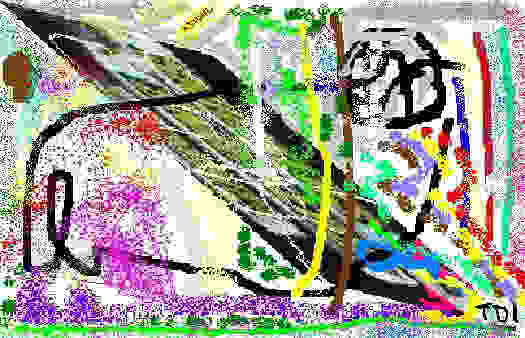|
101 Master
Works
Opus_77

A Kata in the
Void of Space without Golden Bird
TDI, 2005, Museum of
Modern Martial Art
Reprint of a review with kind permission by the
"Magazine for
Non Obedient Martial
Art".
About the
Work
With curiosity and expectation, viewers approach
one of the most influential works of art from the 21th century.
Getting involved into the composition, the initial feeling
of a jumbled mess gives way to a deliberate representation of
multilayered statements. The interpretation of the painting is
guided by knowledge of the artist's personal
background.
A first superficial contemplation shows a diagonal angular
shape, which is surrounded by a scattered display of colors and
forms. Here the firm order depicts a generalised notion of
traditional martial arts, which provides beginners with a first
orientation in the budo world. While the representation's
rigidity is advantageous at the outset, the regimented style
turns more and more into a basis for further exploration of the
surroundings, with forms melting, getting exchangeable, and finally
blending with the
content.
This work is a
snapshot in time, where the origin can be deduced by the
painting's intrinsic movements. A closer inspection reveals a
subtler perspective. In the middle, one perceives the formerly solid
martial art, whose forms and content are more and more corrupted and
eventually annihilated by the influence of one or multiple
antisenseis.
This inherent
process of decomposition is based on a narcissistic-hedonistic
interdependence philosophy between monarchic delusion and consumers,
which is subsumed under the antisenseiism ideogram and substantiated
by murky chromatics and mucous shapes generating an
odious climate contrasting with the initial
association.
At this, the doer,
in literature known as an antisensei, attempts to undermine other
areas, willing to assume any shape and viewpoint that seem
useful to annex foreign color
sets.
Already during the devastation, new styles evolve in
parts of the remaining painting, which interact with each other over
time and space. Even the monochromatic belt as a former
regulatory icon mutates to different emblems,
with the cow pat as the most prominent
insignia.
While the
antisensei domains are characterised by instantaneous adaption
to opportunistic axiologies, the traditional spheres are
defined by a rigid grammar, which produces megalomaniac resistant
artefacts.
Still, a
co-occurence of antisensei misconduct with other objects usually
causes simmering alienation coupled with simultaneous coddling,
which differs from a desirable gentle-energetic chaos by
despicable austerity and
self-deception.
Empiricism proves
here and now that the penetrating conciliatory habit of the
hipocrite induces a pandemic circumference of the solipsistic
apparition. As a periodic epiphenomenon of vulgar manipulation by
inflationary colorings, the fermenting reality escapes as a
denounciating verbal
fart.
In an immaculate
equilibrium system, pure antisensei areas emit only few
opportunities for charlatanry, whose very limited colorations have
to recognize the bordering club tints as an
absolute boundary for their own
development.
At no time
does the artist deny the possibility of parasitic influences. While
some areas indicate the tendency to unadulterated forms and colors,
others seem already infected by the creeping doctrine of
neo-antisenseiism. Even the at first outside observer is pulled
into this desolate mood, which can only be escaped by
choosing a completely new starting point for advanced studies of the
exhibit.
Similar to the installation "Landscape with
Tree and White Belt", the seeming ambiguity of the work simplifies
to a unique composition with only one coherent, albeit
multidimensional, interpretation, in which the antisensei is
portrayed as a rhythm-varying megalomaniac figure, triggering a
paint plague, which in turn generates the precondition for his
own destruction, after which the power of strength regaining color
fantasies will prevail for a further undetermined period of
time.
There remains the
question of the golden bird, which turns out to be the very
answer of the painting. The way, the Do, as the true goal, not
recognizable within the artwork but only inferable through the
symbiosis of concurrent allusions, is entrusted the role of hope,
embodied by the new belt color
"Silver".
About the
Artist
TDI is
founder and influential representative of the "Obstructing
Anti-Antisenseiism" style. He became known to a broad audience when
his event "Rembrandt before and after the bomb" was forbidden at the
very last minute. This attempt to protest against the destruction of
the work of old masters by misuse of new technology provoked
a simmering conflict between politicians and antisensei
lobby on the one side and artists and gun lobby on the
other.
After
these events, TDI focused his efforts on mentally reproducing the
overenergizing process and to generalise from the case study of
antisenseis to the entirety of charlatanry. This created a
completely new asthetics of verbal-epitasis, which, together with
the artist's often self-destructing nature, leads to the
de-tabooing of societal mass
psychoses.
The artist
about himself
When I put
a painting by Pollock into the microwave, I realized that the
destruction of the superficial reveals the content, setting free a
continuum of colors and forms. Since then I am searching for the
ippon in visual arts.
© 2008
SWV | ![]()